Hops in Beer Brewing: Styrian Golding
Published: July 23, 2025 at 6:27:15 AM UTC
Last updated: November 25, 2025 at 2:08:17 PM UTC
Beer brewing is an art that demands precision and the right ingredients. The type of hops used is critical, with Styrian Golding being a favorite among brewers. This hop variety hails from Slovenia, known for its delicate mix of earthy, floral, and fruity notes. It's a versatile ingredient, fitting well into many beer styles. By grasping the characteristics and uses of Styrian Golding hops, brewers can tap into their full capability. They can craft unique beers that highlight their distinct flavor.
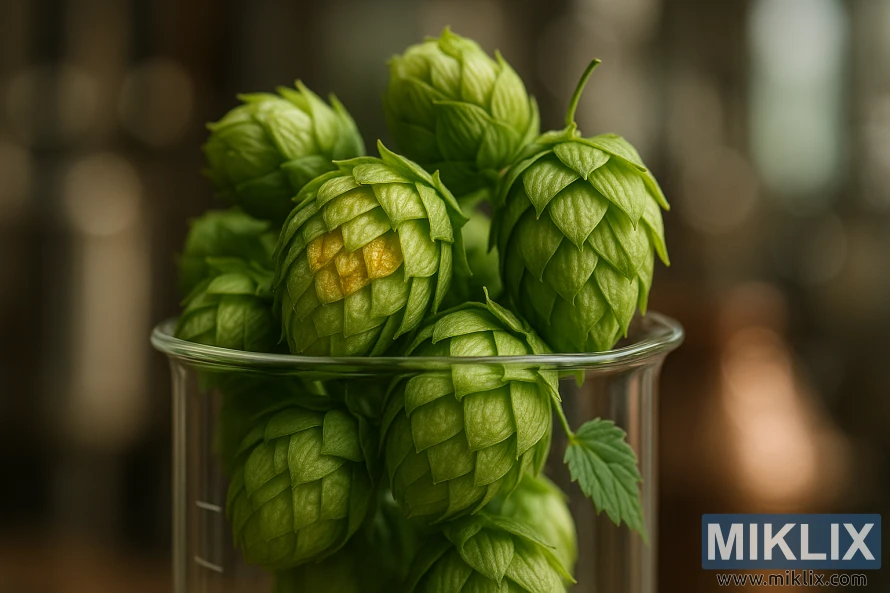
Key Takeaways
- Styrian Golding hops offer a delicate balance of earthy, floral, and fruity notes.
- This traditional hop variety is versatile and suitable for various beer styles.
- Understanding the characteristics of Styrian Golding hops is critical for brewers.
- Using Styrian Golding hops can help create unique beers with distinct flavor profiles.
- Styrian Golding hops are a popular choice among brewers due to their versatility.
Introduction to Styrian Golding Hops
Styrian Golding hops trace their roots back to British Fuggle hops. They were introduced to Slovenia's Savinja region in the early 20th century. Over time, they developed distinct characteristics shaped by their new environment.
The climate and soil of Slovenia have significantly influenced Styrian Golding hops. This has made them a sought-after ingredient for brewers. They add a unique European touch to beers.
Styrian Golding hops are versatile, suitable for various beer styles. Their mild, spicy flavor is perfect for creating complex, balanced brews.
The history and unique traits of Styrian Golding hops are captivating for brewers. Exploring their origins and adaptation to Slovenian conditions offers valuable insights. It helps brewers understand their use in modern brewing.
The Unique Characteristics of Styrian Golding Hops
Styrian Golding hops are celebrated for their complex yet subtle flavor profile. They are a favorite among brewers for this reason. These hops offer a delicate balance of earthy, floral, and fruity notes, creating a unique taste experience.
The flavor profile of Styrian Golding hops is shaped by several factors. Climate, soil conditions, and brewing techniques all play a role. For example, the hop's origin can add distinct earthy and herbal notes. The brewing process can then enhance or reduce these flavors.
The aroma of Styrian Golding hops is also highly valued. They have a subtle blend of floral and spicy notes. This adds depth and complexity to various beer styles. The timing of hop additions in the brewing process greatly affects the beer's aroma.
Brewers can use Styrian Golding hops to create a variety of beer flavors. By understanding how different factors impact their flavor and aroma, brewers can craft beers that are both complex and balanced.
In summary, Styrian Golding hops provide a nuanced flavor profile and aroma. Their unique characteristics, influenced by natural and brewing-related factors, allow for a wide range of beer styles.
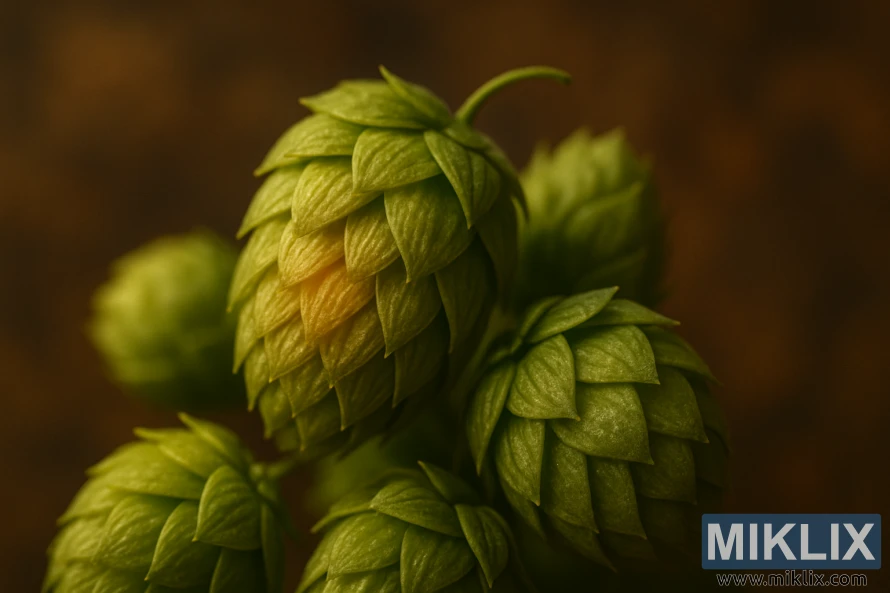
Chemical Composition and Brewing Properties
Grasping the chemical makeup of Styrian Golding hops is essential for tapping into their full brewing capabilities. These hops are distinguished by their low alpha acid content, which falls between 2.5% and 5.5%. This trait positions them ideally for late additions or dry hopping. It allows their nuanced bitterness and rich flavor to shine through.
The alpha acid content in hops is a critical determinant of the beer's bitterness. Given their low alpha acid levels, Styrian Golding hops are not the go-to for bittering. Instead, they're prized for enriching the beer's flavor and aroma with their complex notes.
Hop utilization is about how efficiently the hops' alpha acids are turned into bitterness during brewing. Styrian Golding hops' unique chemical profile impacts their utilization, most noticeably in their addition to the brew. Opting for late additions and dry hopping ensures their delicate flavors and aromas are preserved.
By delving into the chemical composition and brewing properties of Styrian Golding hops, brewers can make strategic choices in their recipes. This leads to beers with balanced and layered flavors.
Aroma and Flavor Profile
Styrian Golding hops offer a distinct sensory experience in beer, marked by their unique aroma and flavor. Their aroma is often noted as earthy and herbal, with a soft spiciness that echoes their Fuggle roots.
The flavor profile is rich and complex, featuring white pepper hints and subtle citrus undertones. This makes Styrian Golding hops a go-to for brewers aiming to craft beers with layered flavors.
In brewing, Styrian Golding hops add to a beer's rich and balanced taste. Their subtle spiciness and earthy notes pair well with various beer styles. This versatility makes them a favorite among brewers.
- The earthy and herbal aroma characteristics of Styrian Golding hops.
- The subtle spiciness and white pepper notes that add depth to the flavor.
- The subtle citrus undertones that enhance the overall complexity of the flavor profile.
Understanding Styrian Golding hops' aroma and flavor profile helps brewers craft unique and complex beers. These beers can satisfy a broad range of palates, making them a valuable addition to any brewer's toolkit.
Best Practices for Storage and Handling
To keep Styrian Golding hops fresh, it's vital to adhere to the best storage and handling practices. The quality of these hops directly impacts their flavor and aroma in beer brewing.
Styrian Golding hops, like other varieties, are sensitive to temperature, humidity, and light. It's essential to store them in a cool, dry environment.
- Store hops in airtight containers or packaging to prevent exposure to air, which can cause oxidation and degradation.
- Keep the storage area at a consistent refrigerated temperature, ideally below 40°F (4°C), to slow down the degradation process.
- Minimize exposure to light, as it can also contribute to the deterioration of hop quality.
When handling Styrian Golding hops, care is necessary to avoid physical damage and contamination. This includes:
- Handling hop packages or containers gently to avoid bruising or tearing.
- Using clean equipment and utensils when handling hops to prevent contamination.
- Minimizing the time hops are exposed to the environment during brewing processes.
By following these best practices, brewers can ensure their Styrian Golding hops stay fresh and of high quality. This contributes to better flavor and aroma in their beers.
Brewing Techniques with Styrian Golding Hops
The art of brewing with Styrian Golding hops requires a deep understanding of late additions and dry hopping. These hops are perfect for late additions, preserving their delicate flavor and aroma in the final beer.
For late additions, brewers must consider timing and quantity. Adding these hops towards the end of the boil or during the whirlpool phase helps retain their volatile compounds. This contributes to a more complex aroma in the beer.
Dry hopping is another technique where Styrian Golding hops shine. By adding these hops to the fermenter or a dry-hopping vessel, brewers can infuse a fresh, hoppy aroma into the beer. It's essential to balance the amount of hops with the beer's other flavors to avoid overpowering the palate.
- Use Styrian Golding hops in late additions to preserve their delicate flavor and aroma.
- Experiment with dry hopping to add a fresh, hoppy character to your beers.
- Balance the hop additions with other ingredients to achieve a harmonious flavor profile.
By mastering these brewing techniques, brewers can unlock the full flavor of Styrian Golding hops. This leads to creating beers with unique and captivating flavor profiles.
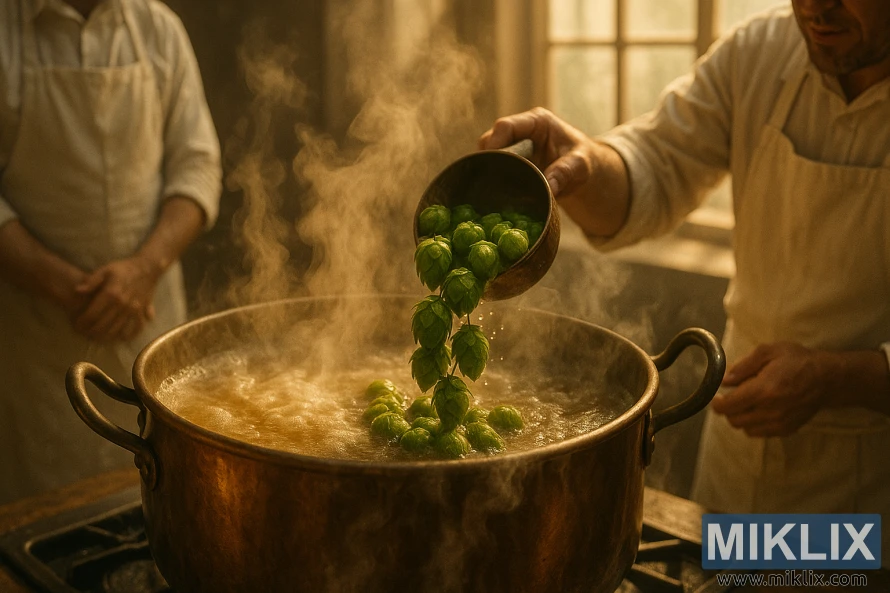
Optimal Timing for Hop Additions
To achieve the desired flavor and aroma, understanding the optimal timing for Styrian Golding hop additions is essential. The timing of hop additions can significantly impact the final characteristics of the beer.
The optimal timing for hop additions depends on the specific brewing technique and the desired flavor and aroma characteristics. Generally, hops added early in the boil contribute to bitterness, while those added later contribute to flavor and aroma.
Here are some guidelines for determining the best time to add Styrian Golding hops:
- Add hops for bitterness at the beginning of the boil, typically 60 minutes before the end.
- For flavor and aroma, add hops later in the boil, usually within 15-30 minutes of the end.
- Consider dry hopping with Styrian Golding hops to enhance aroma without adding bitterness.
Adjusting the hop addition schedule can help achieve the desired balance of bitterness, flavor, and aroma in the final product. Experimenting with different timing can lead to unique and complex beer profiles.
Some common hop addition schedules include:
- Bittering hops: 60 minutes before the end of the boil.
- Flavor/aroma hops: 15-30 minutes before the end of the boil.
- Dry hops: Added after fermentation, typically 1-3 days before packaging.
Compatible Beer Styles
Styrian Golding hops bring a unique aroma and flavor to a wide range of beer styles. This versatility makes them a top choice for brewers aiming to create complex flavors. They are perfect for both traditional and modern beer styles.
These hops pair well with traditional European beers like Pilsner, Lager, and Pale Ale. Their spicy and floral notes enhance the malt, creating a balanced taste. This makes for a refreshing drinking experience.
Styrian Golding hops also excel in modern and experimental beers. They add depth to IPA, Wheat Beer, and Sour Beer. The secret to using them successfully lies in understanding their flavor and aroma.
- Pilsner and Lager: Styrian Golding hops enhance the crisp, clean taste of these beers.
- Pale Ale: They add a subtle hoppy flavor without overpowering the malt.
- IPA: Styrian Golding hops can contribute a unique twist to the hoppy flavor profile.
- Wheat Beer: Their spicy and floral notes can complement the beer's fruity and estery characteristics.
By grasping the compatibility of Styrian Golding hops with different beer styles, brewers can explore new possibilities. Whether crafting traditional or modern beers, these hops are a valuable addition. They offer versatility and enhance the complexity of the brew.
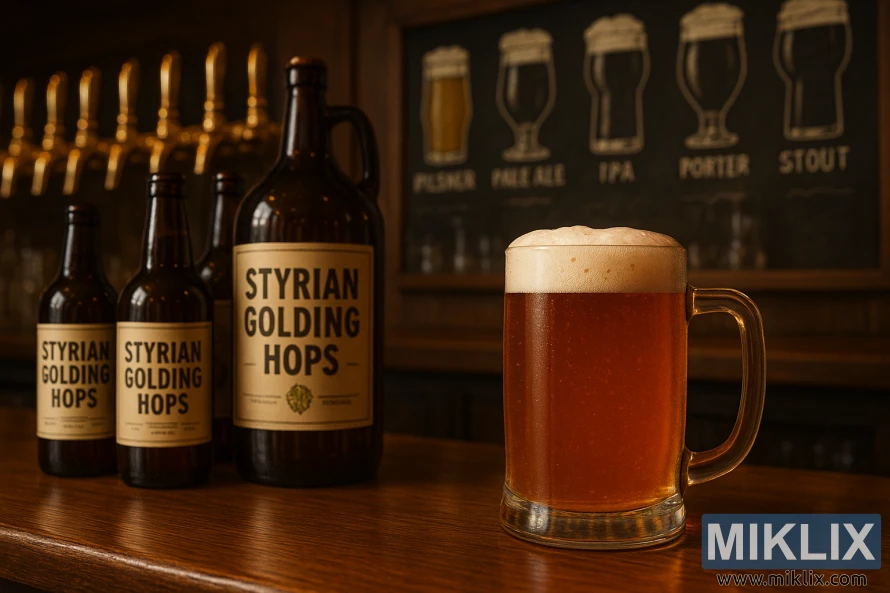
Dry Hopping Methods
Brewers often use dry hopping with Styrian Golding hops to craft complex beer flavors. This technique involves adding hops after fermentation. They then contribute unique flavor and aroma characteristics to the beer.
Dry hopping with Styrian Golding hops introduces a subtle spicy and floral character. Achieving the right flavor and aroma requires understanding optimal timing and methods for hop addition.
- Adding hops directly to the fermenter or a separate dry hopping vessel.
- Using a hop bag or other containment system to make hop removal easier.
- Employing a circulation or agitation system to ensure even hop distribution.
The choice of method depends on the brewing setup and desired outcome. Factors like hop quantity, contact time, and temperature are also critical when dry hopping with Styrian Golding hops.
Best practices for dry hopping with Styrian Golding hops include:
- Using a sufficient quantity of hops to achieve the desired flavor and aroma.
- Monitoring the dry hopping process to avoid over-hopping or contamination.
- Storing dry-hopped beer in a way that preserves the delicate hop flavors and aromas.
By mastering dry hopping techniques with Styrian Golding hops, brewers can create unique and complex beer flavors. These showcase the versatile characteristics of this hop variety.
Substitutes and Complementary Hop Varieties
Exploring substitutes and complementary hop varieties for Styrian Golding can help brewers create unique and complex beer flavors. Styrian Golding hops are known for their distinct aroma and flavor profile. There are situations where brewers might need or want to use alternative hops.
Styrian Golding hops can be substituted with other hop varieties such as Fuggle or Willamette. These hops share similar characteristics with Styrian Golding and can provide a comparable flavor profile in beer. Fuggle hops, for instance, are known for their mild, earthy flavor. Willamette hops offer a slightly spicy and floral note.
In addition to substitution, brewers can also blend Styrian Golding with complementary hops to create unique flavor profiles. Some popular complementary hops include:
- Saaz hops, which add a spicy and floral dimension
- Hallertau hops, known for their traditional European hop flavor
- East Kent Golding hops, which provide a delicate, earthy character
By understanding the characteristics of these alternative and complementary hop varieties, brewers can experiment with new recipes. This enhances their beer's complexity and appeal.
Common Brewing Challenges and Solutions
Styrian Golding hops bring unique challenges to brewing. Brewers often face issues like flavor and aroma inconsistencies. These problems can stem from storage conditions, timing of hop additions, and brewing techniques.
To tackle these challenges, brewers must first pinpoint the cause. They should check the storage conditions of the hops. It's essential to keep them in a cool, dry place to preserve their alpha acids and oils. Proper storage is key to maintaining the flavor and aroma compounds extracted during brewing.
The timing of hop additions is also critical. Styrian Golding hops are versatile, and their addition at different stages affects the beer's flavor and aroma. For example, adding them late in the boil or during dry hopping can boost the aroma. Early additions, on the other hand, contribute more to bitterness.
- Monitor and adjust storage conditions for Styrian Golding hops.
- Optimize hop addition timing based on the desired flavor and aroma characteristics.
- Experiment with different brewing techniques to find the optimal method for showing off Styrian Golding hops.
Understanding the challenges and implementing these solutions helps brewers achieve their desired flavor and aroma profiles. This not only improves the beer's quality but also allows brewers to fully exploit the unique qualities of Styrian Golding hops.
Commercial Examples of Beers Using Styrian Golding
Many breweries have successfully incorporated Styrian Golding hops into their beers. This has resulted in a range of unique and delicious brews. These commercial examples showcase the versatility and the great taste of Styrian Golding hops in various beer styles.
Some notable breweries have used Styrian Golding hops in their flagship beers. This demonstrates the hops' ability to add complexity and depth to different beer styles. For instance, some pale ales and lagers have benefited from the spicy and floral notes that Styrian Golding hops provide.
A few examples of commercial beers that use Styrian Golding hops include:
- Pilsner Urquell, a Czech pilsner that uses Styrian Golding hops to add a subtle spicy flavor.
- Some American craft breweries have also adopted Styrian Golding hops in their recipes. They create unique interpretations of traditional beer styles.
- Other breweries have experimented with Styrian Golding hops in seasonal and specialty beers. This showcases the hops' versatility.
These examples illustrate the great use of Styrian Golding hops in commercial brewing. They provide inspiration for brewers to experiment with this versatile hop variety. By examining the use of Styrian Golding hops in various commercial beers, brewers can gain a deeper understanding. This understanding helps them effectively incorporate these hops into their own recipes.
Recipe Development Guidelines
When crafting recipes with Styrian Golding hops, grasping their flavor and aroma is key. These hops bring a spicy, earthy taste and aroma. This can enrich a variety of beer styles.
To make the most of Styrian Golding hops in recipe development, brewers should follow these guidelines:
- Balance the hops' flavor with other ingredients for a cohesive taste.
- Adjust the recipe to highlight the Styrian Golding hops' desired flavors and aromas.
- Think about the beer style and how the Styrian Golding hops will enhance or contrast it.
For example, in a traditional European lager, Styrian Golding hops can add a subtle spicy and earthy touch. On the other hand, in an experimental IPA, they can blend their earthy notes with the bitterness of other hops for a unique taste.
Understanding Styrian Golding hops' characteristics and applying these guidelines allows brewers to create innovative recipes. These recipes showcase the versatility and unique qualities of these hops.
Conclusion
Mastering Styrian Golding hops can transform your brewery's beer offerings, adding unique and complex flavors. Understanding their characteristics, brewing properties, and optimal use is key. This unlocks their full flavor profile.
Experimenting with techniques like dry hopping and timing hop additions allows brewers to innovate and perfect their recipes. Sharing knowledge and experiences within the brewing community can further enhance the use of Styrian Golding hops.
By incorporating Styrian Golding hops into your brewery's offerings, you can create distinctive beers. These beers showcase the hops' subtle yet refined characteristics. As you continue to experiment and master these hops, your brewery will stand out in the competitive craft beer market.
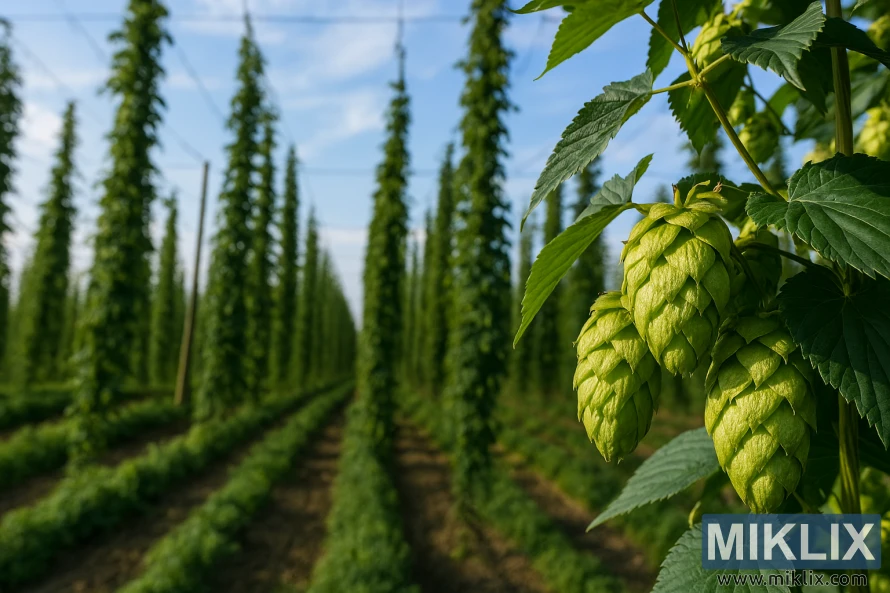
Further Reading
If you enjoyed this post, you may also like these suggestions:
